
It’s been nearly two years since the last Fitbit Charge release, the Fitbit Charge 3. Since that time the company has released a variety of other wearables, mostly minor refreshes. And in some ways the Charge 4, at first glance, might seem to be in that same minor-update ballpark.
But I don’t think it is.
First off, they added GPS to it – huge bump up in capabilities to this category of devices while maintaining the same $ 149 price point. Atop that, they added contactless payments. That feature may not be as big a driver as it would be for an endurance runner, since it’s more likely a casual athlete will have their phone with them anyway. Still, no mainstream (or even non-mainstream company) has offered both those two features at this price point or form factor together. It’s pretty much now in a category of its own.
The question is though – is the GPS any good? And have they improved other aspects of the device. Plus, what the heck is the Spotify app there for anyway? For all those questions and more, I go deep in this review. With everything from explainers on how it works to whether or not GPS or heart rate accuracy is any good. And yes, I’ll try and explain the Spotify bit too. Try, being the operative word.
Now – if you’re looking to digest everything there is to know in about 12 minutes, the following video is definitely for you. Else, you’ll have to digest the other 7,003 words in this post. Your choice.
Still want the words? Good, let’s roll.
What’s new:
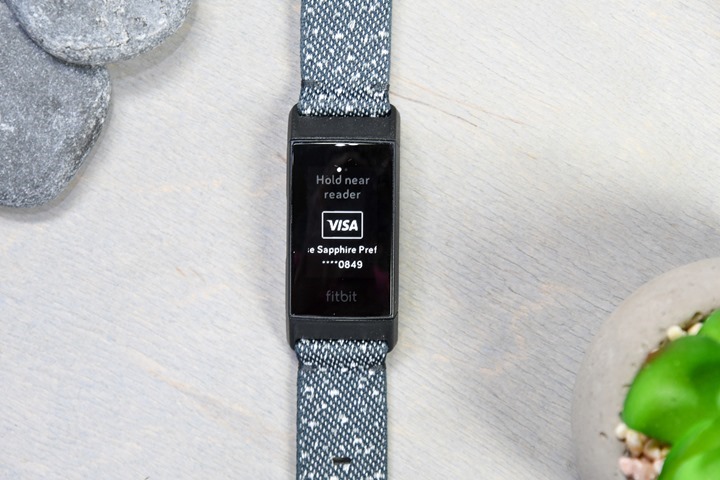
For those Fitbit familiars that just want the quick and dirty on what’s new, you can start here. Of course, I’ll dive into all the nuanced details as always, but this helps you figure out if this is right for you or not.
– Added GPS: Previously it would use your phone’s GPS, but now it actually has GPS built-in, meaning no phone is required for an outside GPS workout
– Added Fitbit Pay contactless payments: You can add your credit card and then tap to pay at stores/massage parlors/etc…
– Added Sleep Score: Essentially gives you a nightly score (0-100) on how your sleep was. You can trend this over time
– Added Sleep Mode: Ability to turn-off notifications and other annoying middle of night things (some of this you can do via Android/iOS anyway)
– Adding Smart Wake: While not in the product at launch, the company is planning to add this down the road
– Added Spotify Control: This allows you to control Spotify from your wrist (playing on another device like your phone or computer). There is no music stored or streamed directly on the Fitbit Charge 4
– Added Agenda: You can now see planned calendar appointments for the day
– Added Workout Intensity Map: This will show HR & pace zones coloring on the GPS map post-workout
– Added more clock faces: They’ve added more clock/watch faces to the Charge 4, for some 24 different clock faces in all
Obviously, the biggies here are the addition of GPS & contactless payments, all while the unit having a sub-$ 150 price point. There’s simply nothing else in the ballpark that has that. The next most viable mainstream unit with that duo of features in the wearables realm would be the Apple Watch Series 3 or Samsung Galaxy Active Watch/Watch 2 (depending on sales) at $ 199. Both of those though require roughly daily charging, whereas the Fitbit lasts a solid 4-5 days (though, far less with GPS usage – max 5 hours per spec).
The other features are more nice to haves that round-out the user experience. The new sleep score metric makes sense, and is there probably to make a point comparative to Apple’s offerings which lack any native sleep tracking. Whereas the Spotify control is mostly useless in practice, based on my testing, similar to how it was mostly useless on the Fitbit Versa 2 last year. It’s just cumbersome.
But again, the Charge 4 is all about GPS & contactless payments. That’s the major wins here, and at this price it’s pretty significant. The question is, is the GPS actually accurate?
[Note: For lack of anywhere else to put it, Google obviously announced their intent to acquire Fitbit last fall. However, that acquisition hasn’t actually closed yet. As such, it hasn’t at this juncture had any obvious impact yet. How that changes things long term, nobody has really said. So, we’ll cross that bridge if/when they can receive regulatory approval and close the acquisition.]
What’s in the box:
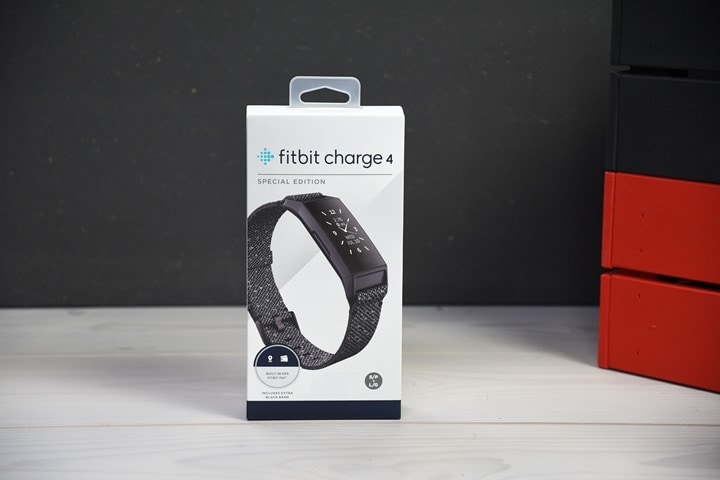
There’s essentially two variants of the Fitbit Charge 4. Though, the actual unit itself is identical. It’s merely a difference of whether or not you get a fancy strap with it. Both editions include all the same features and functions. It’s only the straps that differ. In the ‘Special Edition’ you’ll get a swankier strap, whereas in the base edition you’ll get the standard strap. Both editions include two normal straps: A smaller one, and a larger one. The smaller one fits me just fine.
In my case, Fitbit sent me out a media loaner unit of the ‘Special Edition’ box, so I tried both straps. However, I also went out and bought my own regular edition Fitbit Charge 4. I’ll send back the media loaner shortly.
Once you crack the box open, you’ll find the Charge 4 sitting there:

Under the cover of the lower half of the box is the extra straps (depending on model) and the charging cable. Also, some paper stuffs.
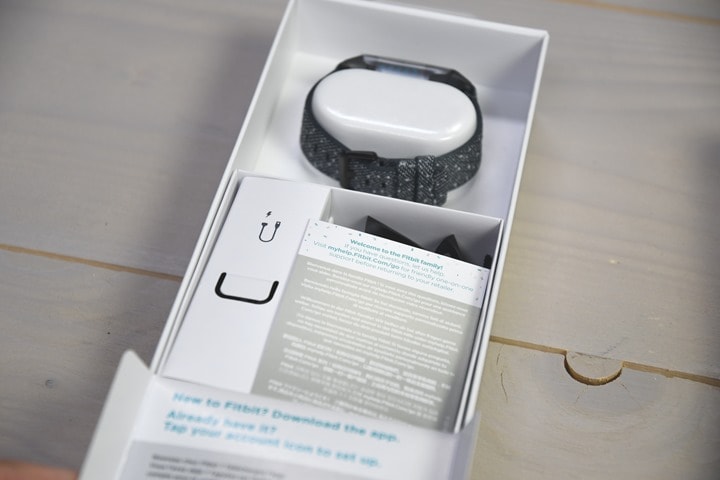
Here’s all the parts on a table. This is for the special edition. With the non-Special Edition, it’s simply just without the fancy strap. Maybe if there’s interest I’ll post those unboxing photos too.

A quick look at the parts, starting with the paper manual. You won’t need it after this post. Though, it does remind you to take off the band every once in a while and rinse it off to avoid any wrist wonk.
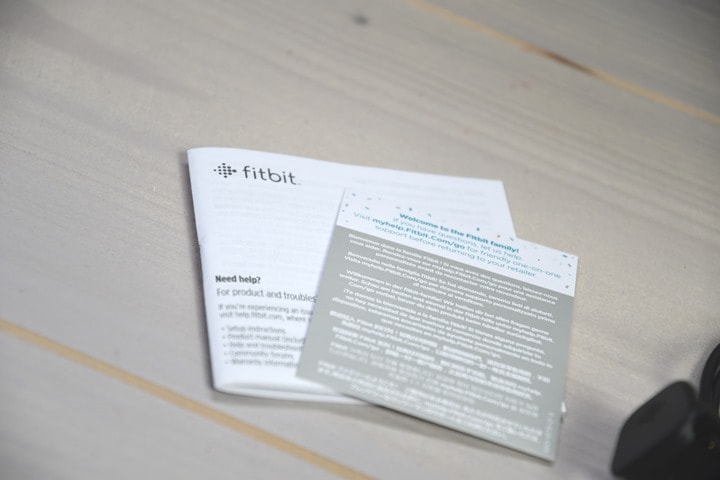
Next is the charging cable. It’s the same as the Fitbit Charge 3. Which is a nice touch (finally!).
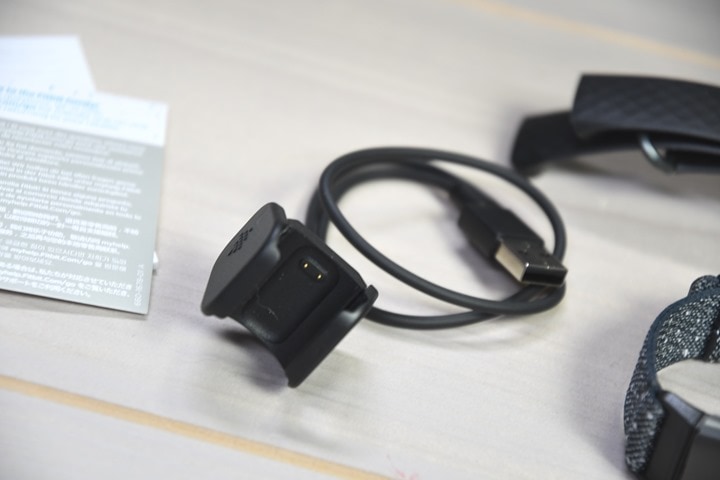
Next, there’s the bands and Charge 4 itself. You can see the longer pretty band strap off the watch, while the set of three regular bands (two different lengths, plus the other side of the strap) is on the table.

Here’s a closer look at both:
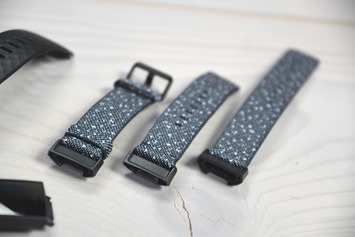
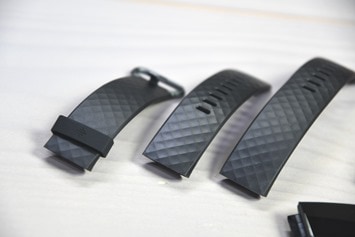
And finally, here’s the underside of the pod itself. Note that the straps detach using the little buttons on each side of them. I’ve never had one fall apart, it’s a well-designed mechanism.
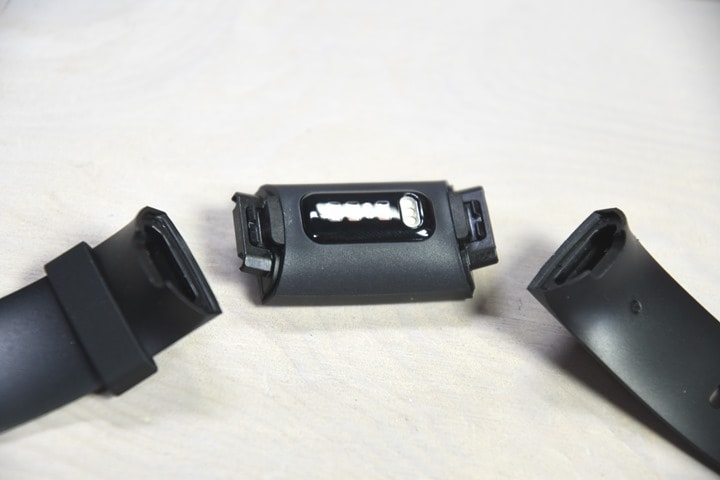
With that, let’s start talking about actual usage.
The Basics:

If you’re familiar with the previous Fitbit Charge 3, then you’ll find yourself right at home with the Fitbit Charge 4 – from a user interface standpoint there’s only minor tweaks. Inversely, if you were looking for the screen to be more visible in bright sun, you won’t find that here. It’s basically same-same.
But, we’re getting slightly ahead of ourselves. Once you’ve finished the quick setup process you’ll find yourself on the ‘clock face’, which is now customizable from approximately 24 different options, via the app:
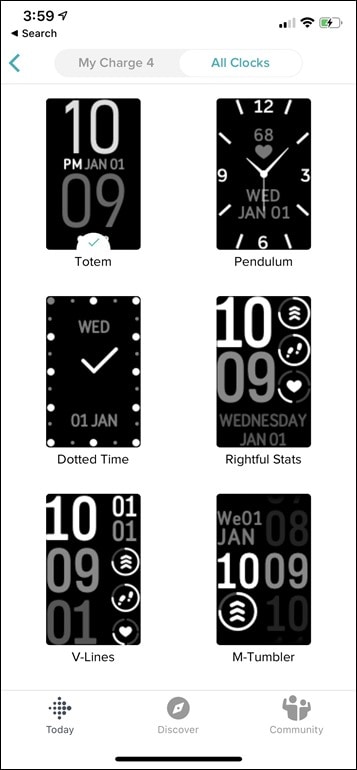
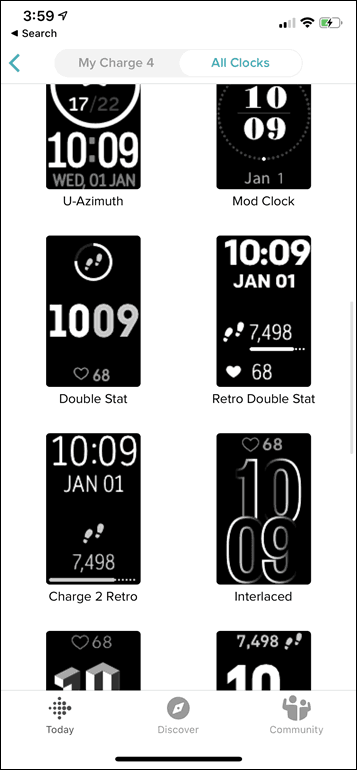
The clock face will show various metrics, depending on which one you’ve selected. The default one shows the date/time in large font, and then down along the bottom you’ve got a single metric which you can tap to rotate through the core metrics of distance walked, stairs, Active Zone minutes, steps, heart rate, and calories.
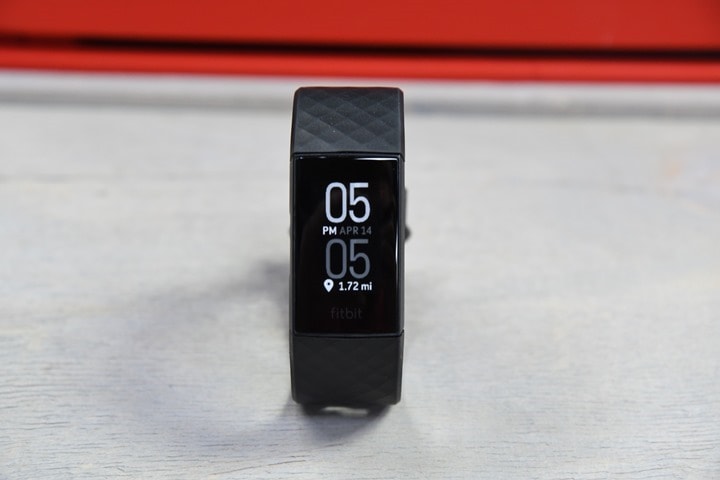
Next, you can swipe up from the bottom to see your totals against the daily and hourly goals, as well as some summary/average. So these can include steps, your hourly step goal, and the sleep score and sleep time. Again, previously the sleep metrics weren’t shown on the wrist. The daily resting HR is a nice touch as well here. You can also see the battery level faintly at the top:


Speaking of faint, the display is not always-on. Meaning it turns off when not actively using it. Anytime you raise your wrist, it’ll usually show up again. However, certain scenarios are more finicky. For example, sitting here typing on my laptop, turning my wrist doesn’t work. Nor does sitting on the couch watching TV (unless you pick up your entire arm and rotate). Some wearables are better here, and some are worse. Fitbit is mostly middle of the road when it comes to gesture recognition. You can always press the side button, or tap the display to turn it on.
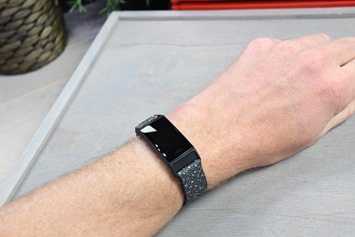
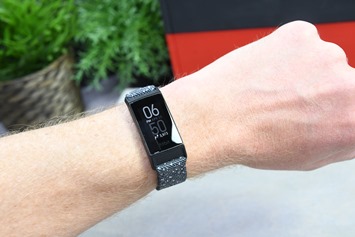
Meanwhile, most of the actual ‘goods’ are found by swiping from the right. The first page has the workout option (to start a workout), as well as Spotify control.
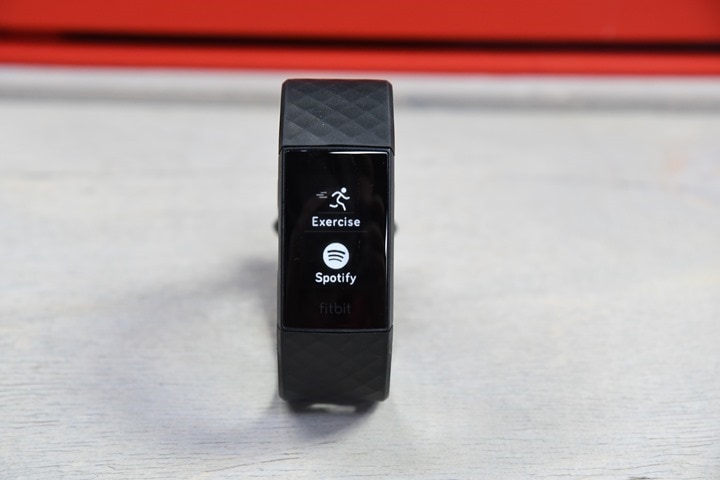
I’ll cover the workout bits down below in the dedicated workout section. Meanwhile, for Spotify, that controls Spotify on connected devices. That’s actually not just limited to your phone, but even works to control Spotify on your desktop or other devices. It does NOT store music on the Charge 4, nor does it stream music to the Charge 4. It’s just like a mini remote control for your other devices.
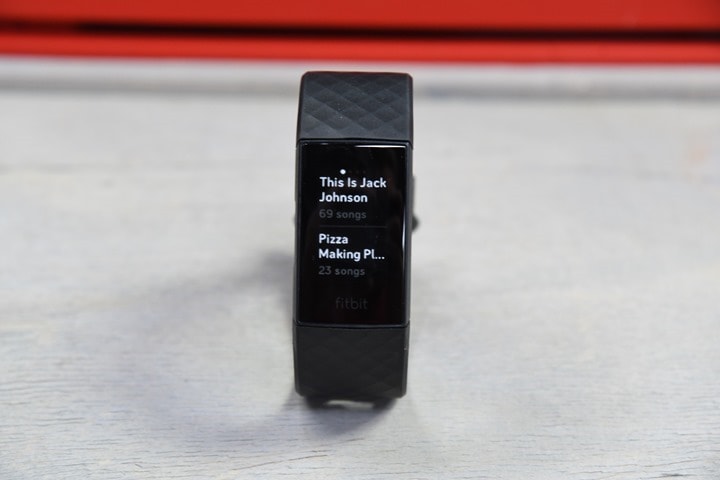
You can swipe through playlists, skip songs, as well as play/pause. I found it finicky at best (when it actually connected). And oft cited an error to connect and told me to restart various apps. But even when it did work, it’s just not super practical. It’s a million times faster to grab my phone and control my music. Sure, there’s probably some gym scenarios where your phone is in a nearby bag and you’re wearing headphones and somehow this is easier. But those are very few and far between.
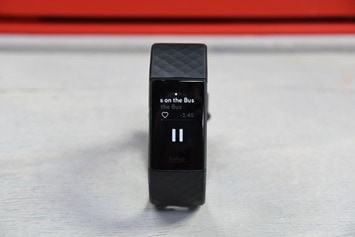
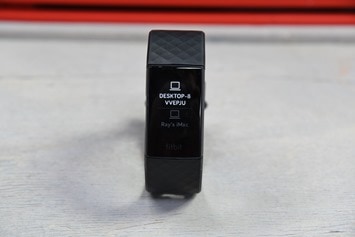
The next ‘page’ on the Charge 4 app dashboard includes your Agenda and the Relax app. The agenda will show upcoming calendar appointments. You can also configure it to show free-time as well.
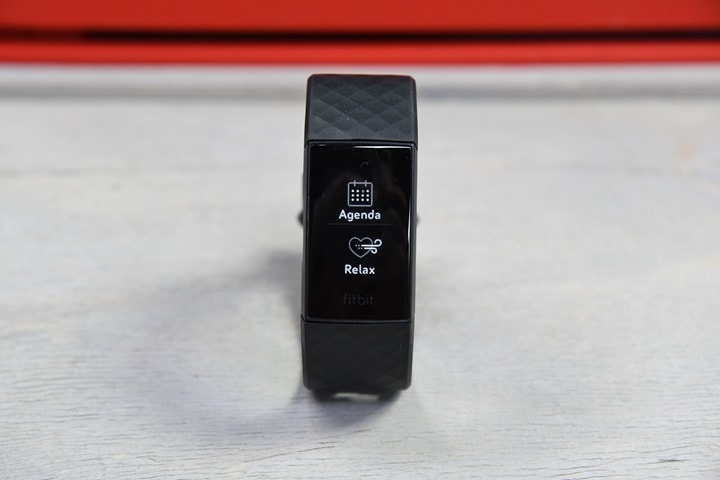
You’ll need to configure permissions for that within the Fitbit app, so it can access your calendars. Meanwhile, the Relax timer was introduced in previous Fitbit products and walks you through breathing exercises:
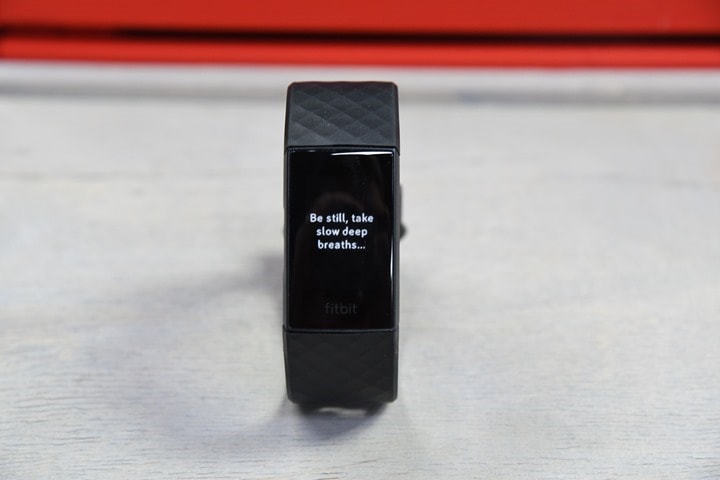
The next page has both timers and alarms. For timers, there’s a Stopwatch and Countdown timer. While the Alarms feature allows you to set up an alarm, which can be recurring on specific days per how you configure it. You can configure multiple alarms.
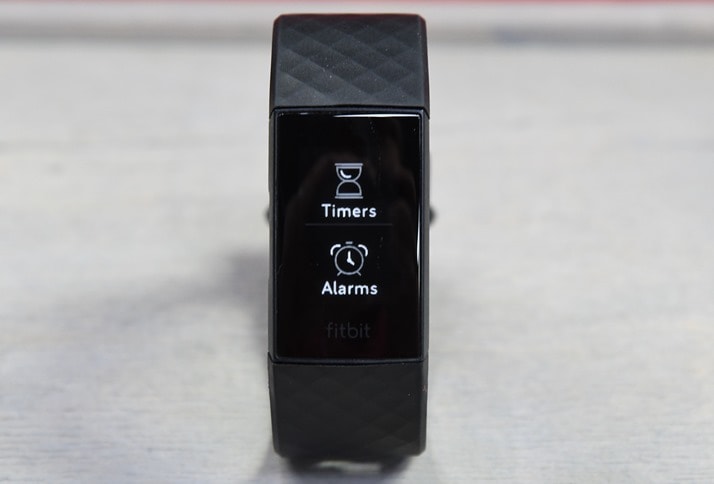
Finally, there’s the new Weather app, as well as the settings. For weather, it’ll use your current location (or, what it thinks it is anyway), or you can have it pull specific locations instead (by adding city-names on the app):
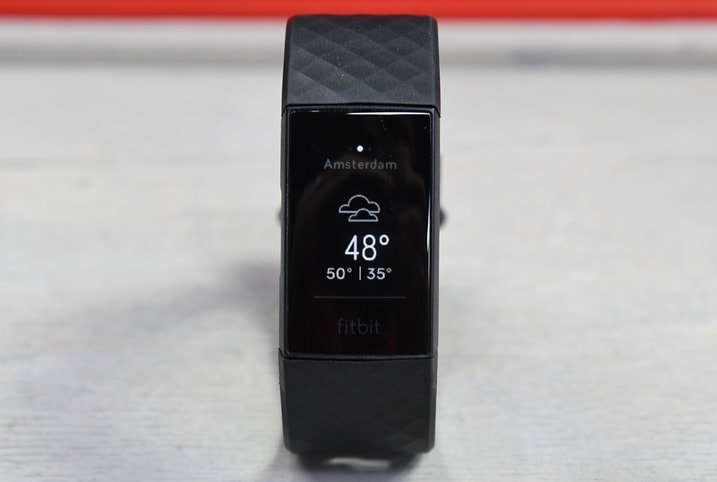
Then down in the regular settings option you can tweak all sorts of things. For example, there’s the brightness level (options include Dim, Normal, Auto), as well as the vibration levels (normal, strong), heart rate tracking, do not disturb mode, sleep modes, and heart rate zones.
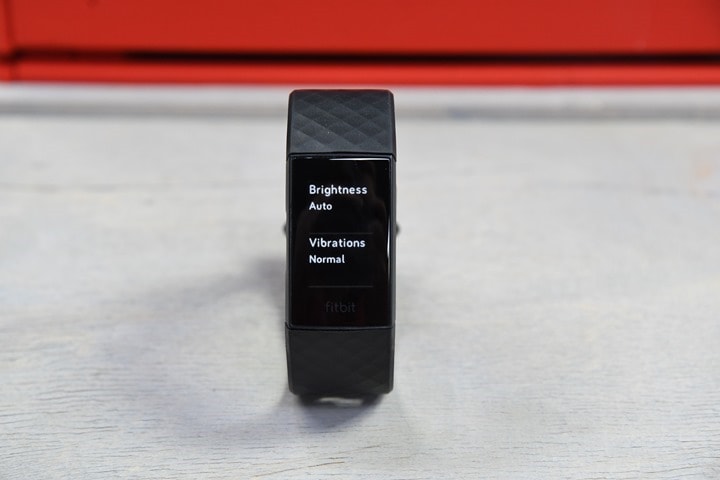
The sleep modes are notable because you can set a specific schedule, which then will automatically enable the sleep mode between those hours.
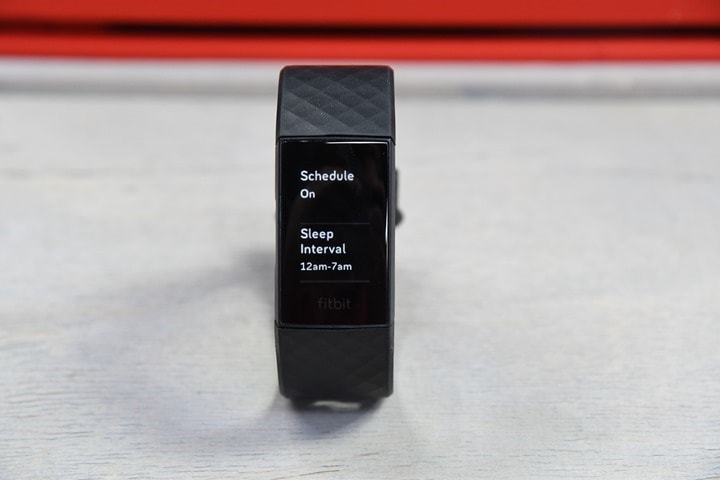
Remember, the sleep mode basically silences notices and reminders, as well as disables the screen from turning on. Because while that screen may be impossible to see in bright daylight outside, it’s an effin blowtorch at night in a dark room in bed when you turn your wrist and effectively blind your BFF.
Speaking of sleep, heading over to the app, you’ll see all your sleep stats there. It’ll show you that new sleep score, which is on a scale of 0-100. And you can plot sleep a number of ways from the Sleep Score to time slept to sleep schedule to hours in sleep stages. The world is your oyster here:
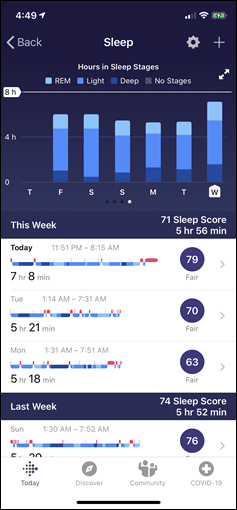
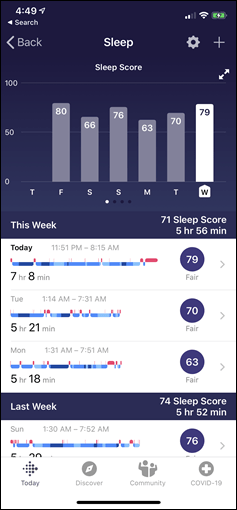
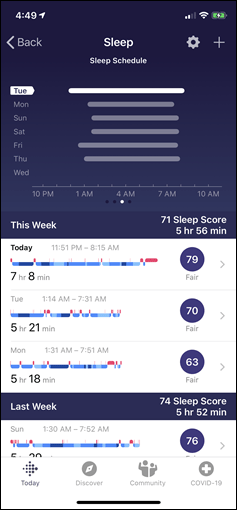
You can also look more closely at any given night as well. And then if you’ve got the Fitbit Premium subscription, it’ll also offer various programs to try and get your sleep on track (or somehow better):
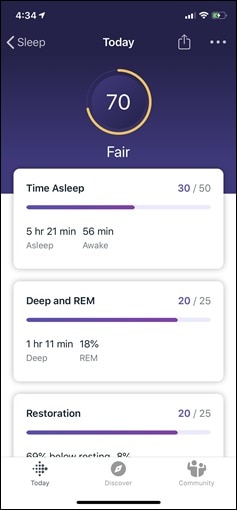
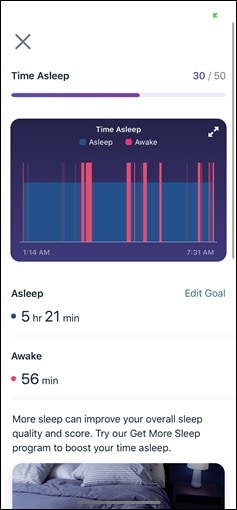
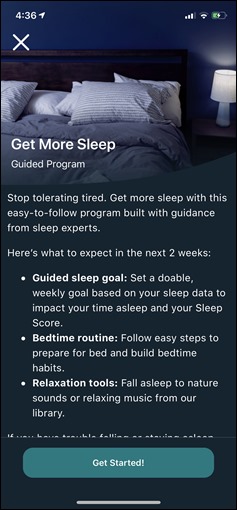
Unfortunately, none of these programs appear to offer a service for dealing with crying babies or toddlers departing their beds at 3AM. Thus, I wasn’t really able to leverage these to any success. Maybe in another decade or so.
Heading a bit backwards in the app, there’s the main dashboard. This is where you’ll see your metrics for the day. Keep in mind that these metrics are showing distance walked/ran, and not inclusive of things like cycling. On this screenshot, I had already ridden for 90 minutes. however, that’s why you see the ‘Zone Mins’ higher at 106.
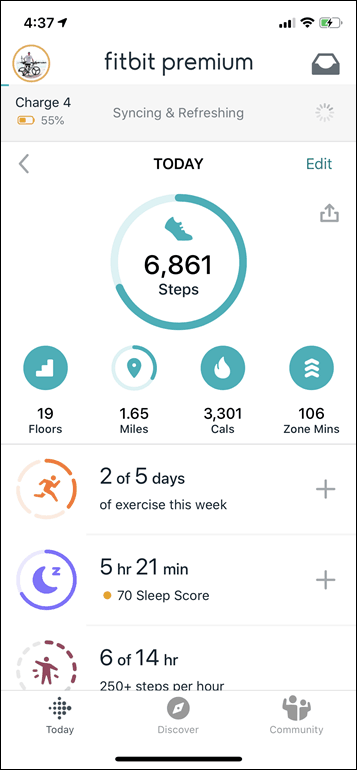
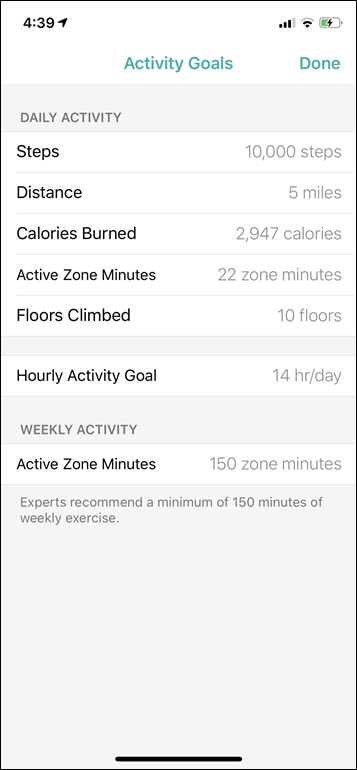
You can tap any of the metrics to get a more detailed view of that metric (and longer-term reporting), including the ability to tweak the defined goals for it.
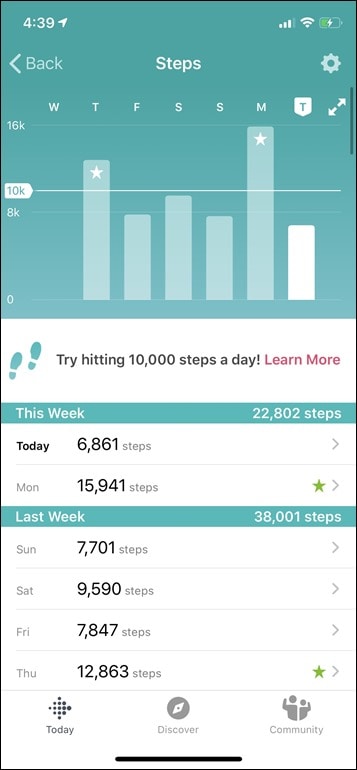

For your heart rate, the Charge 4 is constantly monitoring your heart rate 24×7 using the optical HR sensor on the back of it:
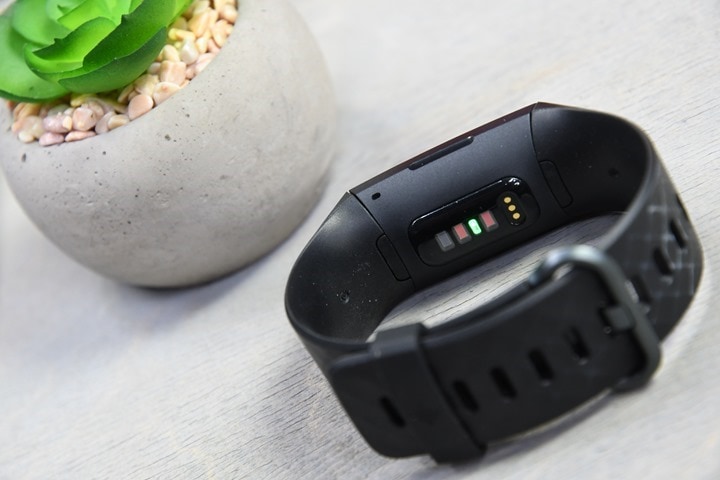
All of this data is fed into the app as well, and you can see the daily trends. This also includes the points where your workouts show up too. In my case, the gaps are when I needed to recharge it. Given I did some longer rides in the last few days (2-3+ hours), I burned through GPS more quickly.
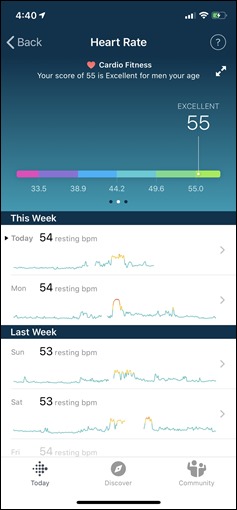
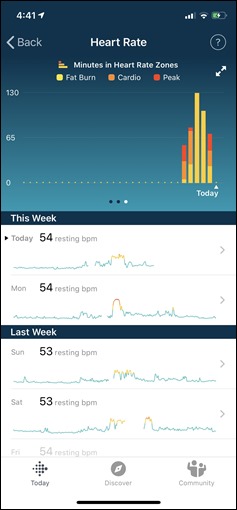
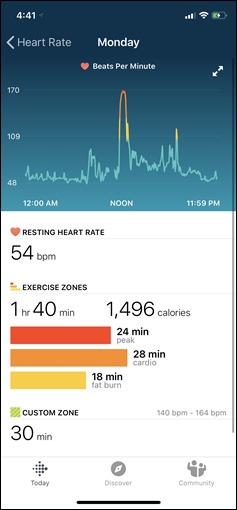
Lastly on the list of notable Charge 4 features is, of course, the new Fitbit Pay contactless payments, which allows you to load a credit/debit card onto the unit and then tap to pay at various merchants. Fitbit has a list of the banks that are supported here. Remember, it’s not about supporting Visa or AMEX or what-not, but the exact issuing bank of your card. Which means Fitbit (just like Apple does) has to literally talk to every single bank in the world and get it hooked up. Yikes.
In the US, most of the major banks are supported. Outside the US it varies. For example, my US Chase credit cards are supported, but my Netherlands based ING cards aren’t. Nor are my French based HSBC cards.
Assuming your card is supported, then adding it is pretty easy. They’ve got a little wizard they’ll walk you through, which includes setting a PIN to access the credit card pieces (from the wrist).
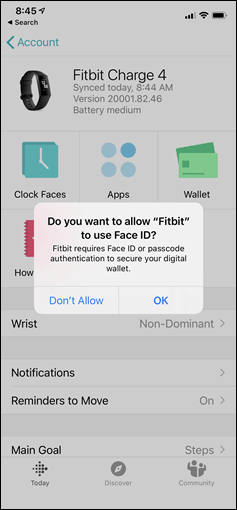
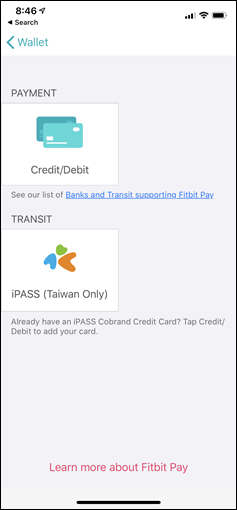
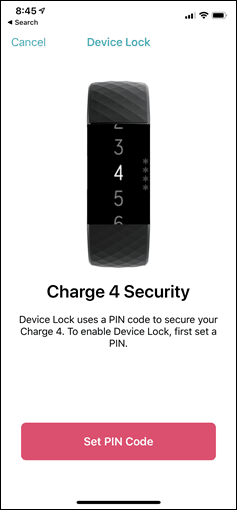
You’ll then enter in your card manually, as well as address information. Also, you’ll have to agree to the terms/conditions of your card issuer:
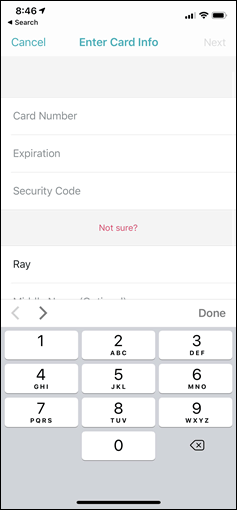
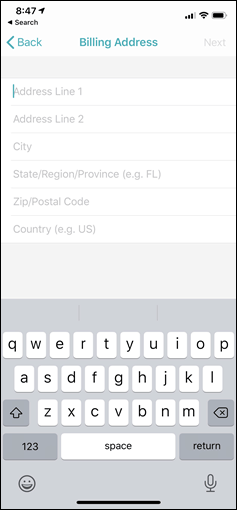

After that’s done you’ll get a text from your issuer to confirm the card. At which point you’ll see it listed on the app to use. Which in turn means you can use it on your wrist. To do that, you’ll long-hold the only button there is (on the left side).
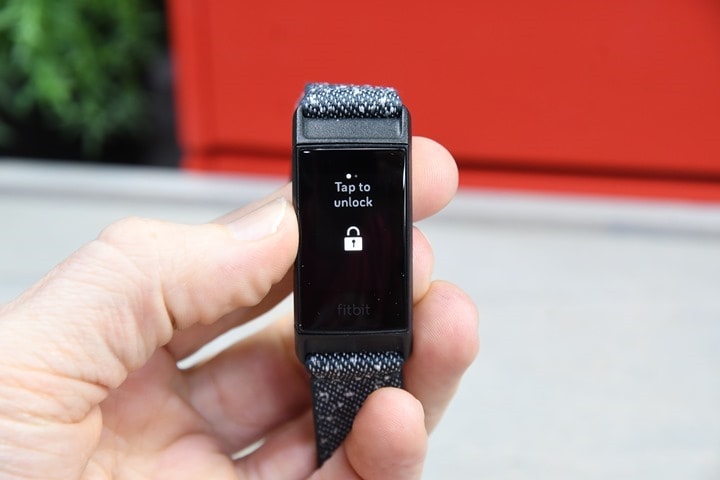
You’ll then need to enter in your pin. This part is a bit finicky, because you need to scroll up/down through a list and then tap. It’s non-ideal, but it’s also not something you do every hour either (unless you’re a really strong shopper).
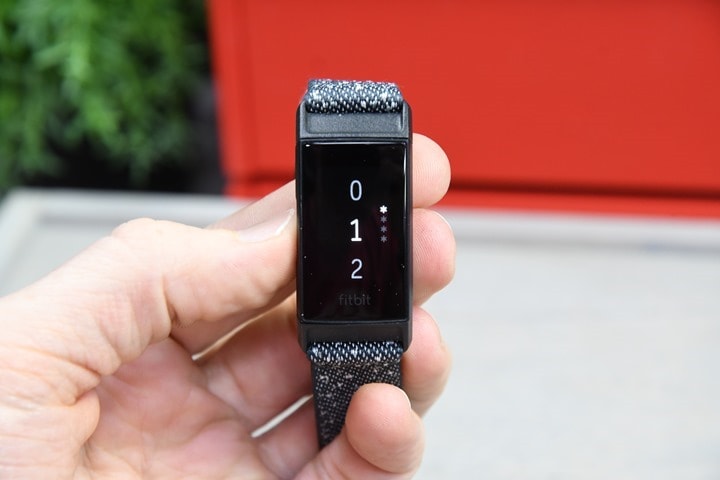
After that, it’ll show your card logo and the last four digits, which is where you can hold it next to a card reader to pay for your single roll of toilet paper you managed to find.
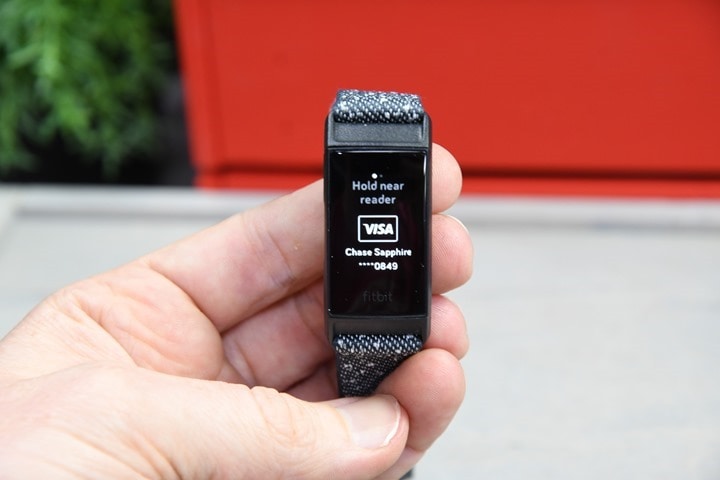
Ok, with that we’ve wrapped up all the day to day activity tracking portions, so let’s dive a bit further into the sports tracking, especially with the GPS pieces.
Sports & Workout Tracking:
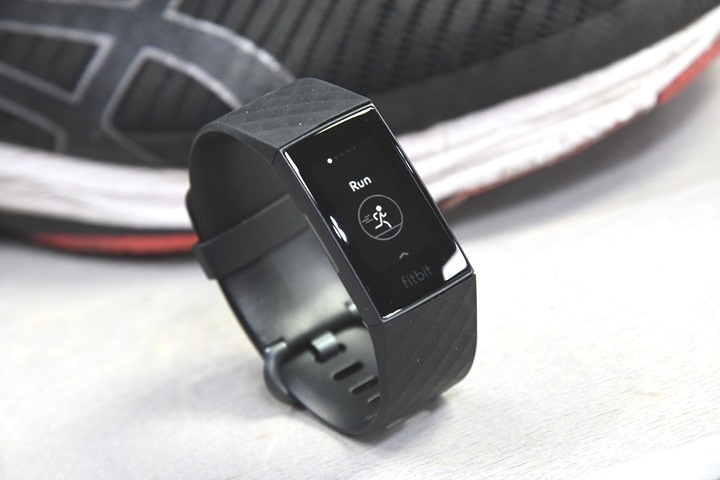
Sure, the Charge series could always record workouts in some manner, even using the GPS of your phone. But with the addition of GPS into the Charge 4, it’s basically a mini GPS sport watch. For the basics anyway. So let’s dive straight into that.
To access the GPS modes, you’ll need to start an exercise. At this juncture, there’s really no difference between GPS or non-GPS activities. You’ll swipe right once, and choose exercise.
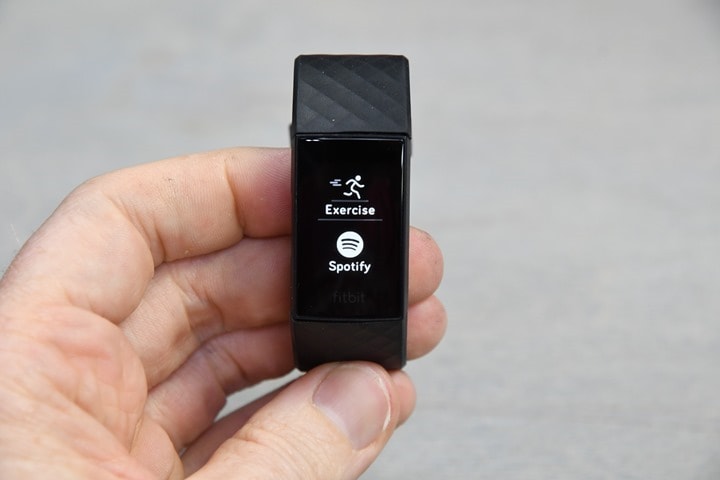
Next, you can choose one of the sport modes. By default there’s six of these: Run, Bike, Swim (indoor), Treadmill, Outdoor Workout, Walk.
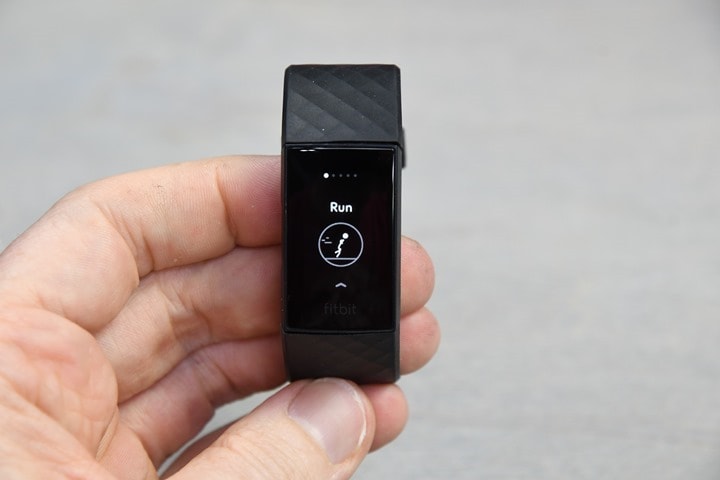
Which sports you choose are customizable via the Fitbit app, but more on that selection in a moment.
Below the screen for each sport on the Charge 4 is an option to turn GPS on or off for that sport, as well as configure auto-detect, auto-pause, and heart rate zone alerts:
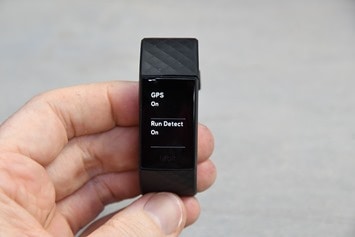
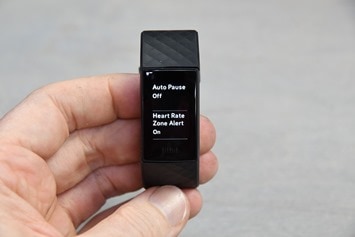
Once you tap a sport mode it’ll give you the option to either Start that sport or set a goal. A goal can be based on distance, time, calories, or zone minutes.

Once you tap that start button, it doesn’t actually start yet. Instead, it goes off and looks for GPS. Once it’s done with that, it’ll show the words ‘Connected’, which means it’s ready to roll. In my experience this takes about 5-10 seconds at most.
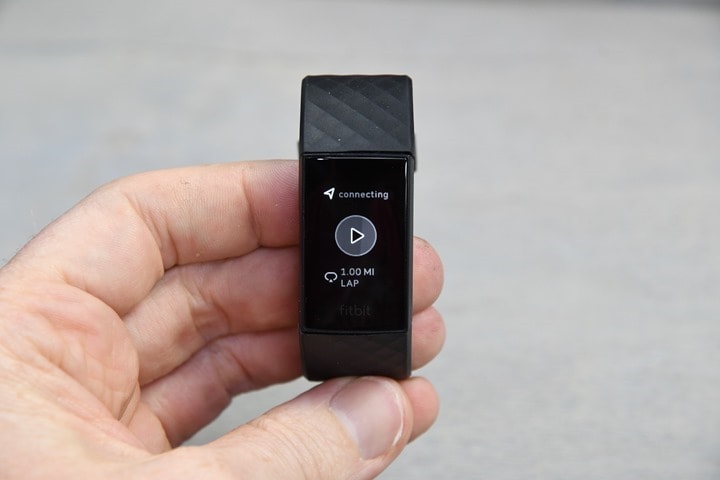
After you press the play button, then it’ll start recording for realz. It’ll also show you your data. Exactly what is displayed will of course vary slightly on the sport. For example, in running, your distance is always shown at the top (total distance), then in the middle is a changeable data field, while at the bottom is your total time for the activity.
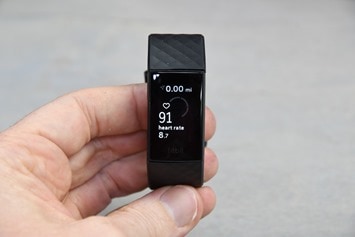

That middle data field will switch to a different metric each time you tap the screen. Those metrics (for running) are: Distance, Activity Elapsed Time, Lap Distance, Zone Minutes, Pace (current), Pace (average), heart rate (current), calories, steps (activity), Time of Day.
From a pace stability standpoint (in other words, how stable is the pace while running to use in pacing), it’s not too bad. A bit wobbly occasionally, but not horribly overall. We’ll dive into GPS & HR accuracy in later sections. The only other notable downside is that in bright sun it’s pretty darn hard to see. Can you see it? Yes. Is it super easy to see? Definitely 100% not.
If you’ve got auto-lap setup, then it’ll buzz each time the auto-lap triggers. In this case the default is using distance, and since I’m set to Americana mode, I’ve configured it for miles. But you can change that within the app to calories, minutes, or kilometers. This is configurable on a per sport mode, and then allows you to choose in half-mile or mile increments up to 5 miles.
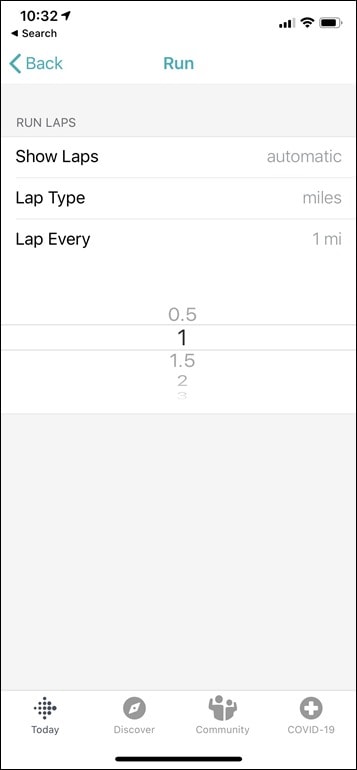
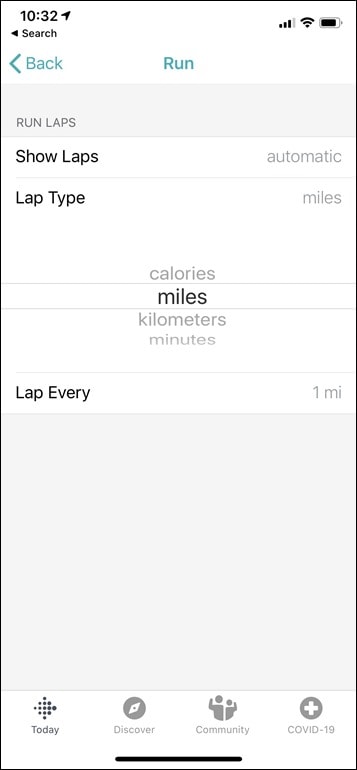
So for example, you’d configure cycling with a different auto-lap settings, which allows you to increase the auto-lap upwards of every 25 miles.
However, ultimately, this is the *only* thing you can configure on sport modes, aside from which sports you select. You can choose a maximum of 6 sports at any one point in time, from any of the sports you see below (the list fit perfectly in the screenshot).
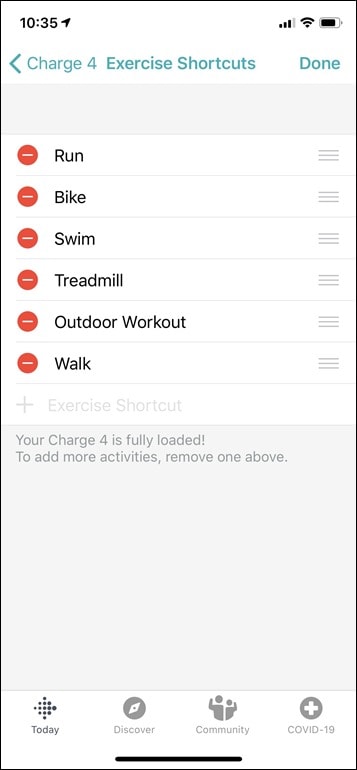

Unlike other lower-end GPS watches though, you can’t customize data fields or data pages within the sport modes. That’s a bit of a tough trade-off, albeit somewhat understandable. Still, there are other watches in this price ballpark that do allow this – but those generally lack the Fitbit finesse. And all of them lack contactless payments.
Note, due to all the pools currently being closed I can’t test the accuracy of the indoor swimming mode. The unit doesn’t support any openwater swim tracking (except time, but no distance/strokes/etc…).
One of the ‘big’ changes with the Charge 4 is the concept of Active Zone minutes and Intensity Zones. Essentially this is partially a rebranding the American Heart Association and World Health Organization’s goal of 150 minutes of exercise per week. Other wearables have long done this based on the same 150 minute goal. These Active Zone minutes are based on a combination of age and heart rate, whereby in higher (more painful) zones you get more minute credits than in lower zones. It’s like earning frequent flyer miles, whereby more expensive tickets get more miles. Here’s an example chart from that support page explaining how it works:

I don’t think it’s a bad concept, and that segues right into the next bit which is the next Heart Rate Zone definitions. You’ll see these zones in numerous places throughout the device, usually next to that triple-up-arrow icon you see in the chart above (which means Active Zones). For example, while in a workout you’ll get notifications each time you change zones. You can lightly customize the upper and lower bounds of the more intense zones within settings on the app (tap your profile pic in the app, and scroll way down for like 5 years):
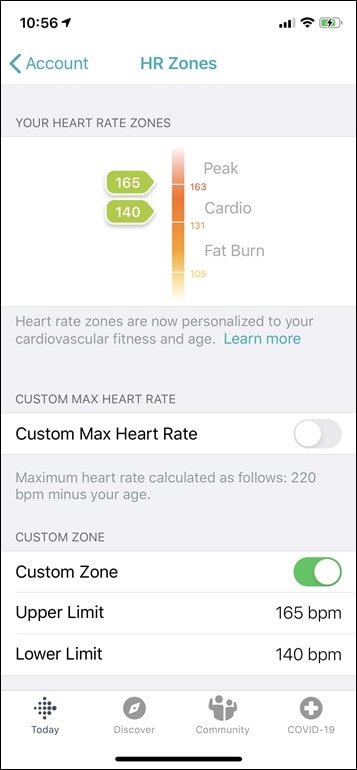
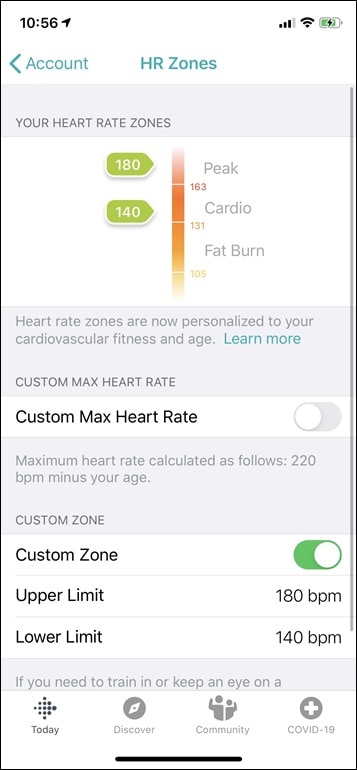
So if you were doing an interval workout, you’ll get notifications as you go in/out of the peak/cardio zones and potentially down into the Fat Burn zone. Then, afterwards on the device, you’ll see your workout totals, including your active zone minutes (but not zone-specified):
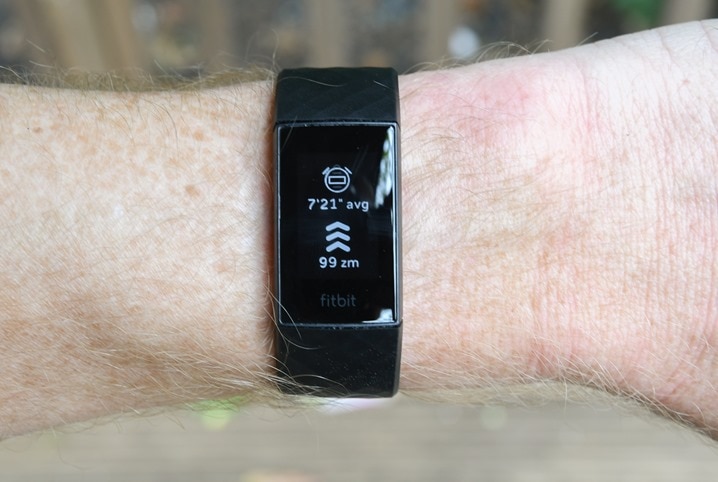
The zone specification is instead shown within the Fitbit app. First, it shows it on the map itself, changing the coloring of each portion of the GPS track. This is actually pretty visible when you do an interval workout, as I did below, as you can see my harder ‘work’ segments in red, and then the recovery bits in orange. You’ll notice how it defines those too down below as cardio/peak zones.
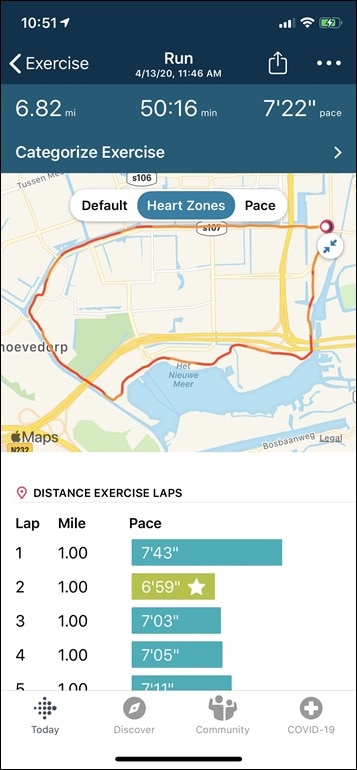
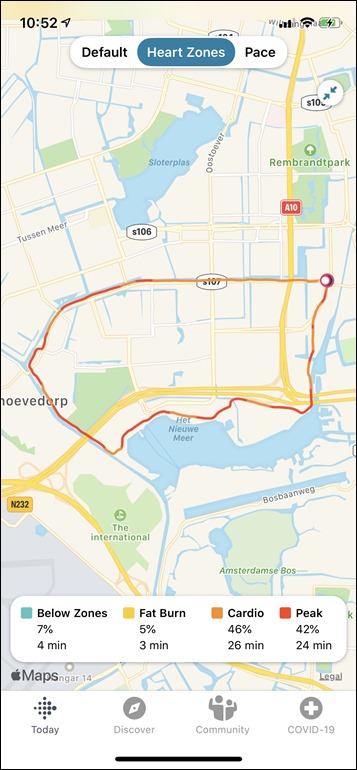
In the app you can also look at pace splits for laps (even on the map), as well as other metrics from your workout:


This workout will also be synced to apps like Strava if you’ve got it connected, or you can share it to social media platforms with photos and other overlays:
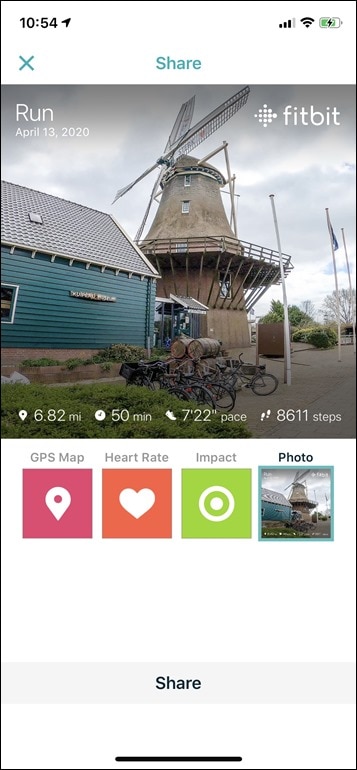
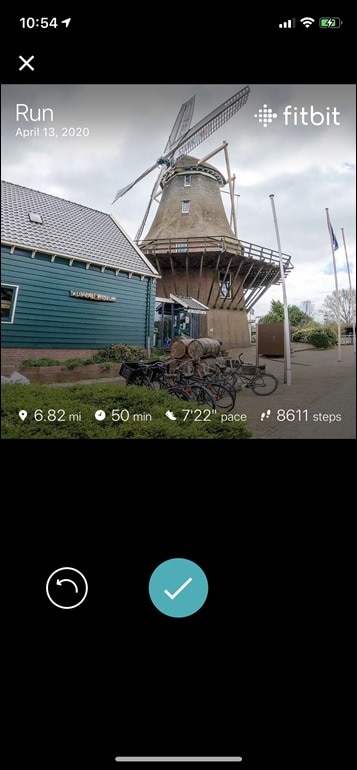
So, what does battery life look like in GPS mode? Well, the simple math is roughly 20-25% per hour in my experience. I did however have one workout whereby in a mere 2hrs it burned through the entire battery from 70% to 0%. However, I suspect the initial 70% battery indicator may have been incorrect (another issue I’ve seen around charging). I haven’t seen that or the underlying issue on subsequent firmware updates though (including the most current firmware), so my hope is that’s a passing bug that’s been resolved.
Ultimately, the new GPS functionality does a pretty good job at turning this into a fairly good simplistic GPS wearable device. The limiter here is battery. Thus, it’s great for a 5K, 10K, or even I suppose a brisk marathon (definitely not my first choice for a marathon however). But it’s less ideal for a long day-hike where you might hike a few hours in the morning, eat lunch, and then a few more hours later on. It likely won’t cut the mustard there.
So – I guess that gets right into the next question, is the GPS accurate?
GPS Accuracy:
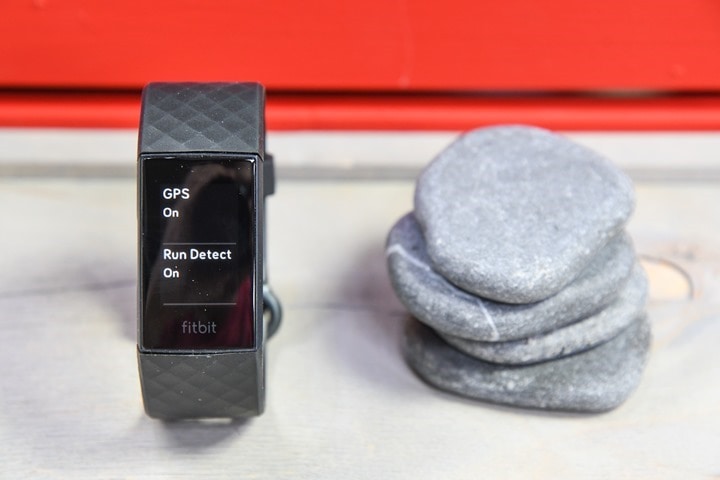
There’s likely no topic that stirs as much discussion and passion as GPS accuracy. A watch could fall apart and give you dire electrical shocks while doing so, but if it shows you on the wrong side of the road? Oh hell no, bring on the fury of the internet!
GPS accuracy can be looked at in a number of different ways, but I prefer to look at it using a number of devices in real-world scenarios across a vast number of activities. I use 2-6 other devices at once, trying to get a clear picture of how a given set of devices handles conditions on a certain day. Conditions include everything from tree/building cover to weather.
Over the years, I’ve continued to tweak my GPS testing methodology. For example, I don’t place two units next to each other on my wrists, as that can impact signal. If I do so, I’ll put a thin fabric spacer of about 1”/3cm between them (I didn’t do that on any of my Fitbit Charge 4 activities however, all workouts only had a single device per wrist). But often I’ll simply carry other units by the straps, or attach them to the shoulder straps of my hydration backpack. Plus, wearing multiple watches on the same wrist is well known to impact optical HR accuracy.
Next, as noted, I use just my daily training routes. Using a single route over and over again isn’t really indicative of real-world conditions, it’s just indicative of one trail. The workouts you see here are just my normal daily workouts.
Note: For all of these tests I did NOT bring my phone (running), and in the case of cycling, I turned off Bluetooth entirely in the control panel, just to ensure it wasn’t leveraging my phone.
First up, we’ll start with something both easy and challenging at the same time: A run in the forest. Sure, there weren’t tall buildings, but there were plenty of tall trees. The route also included more open sections as well. This is compared against a Garmin Fenix 6 and COROS Vertix. There was also a Timex R300 GPS, but alas their app doesn’t allow exporting of files directly unless it syncs to Strava first (which this one didn’t). In any case, here’s the high-level overview (and data set):

At a high level it doesn’t look too different, but the more you zoom in, you start to see some variances. We’ll first look at the upper half, which is a blend of trees and fields, alternating.

And while somewhat hard to see with the green line below, you can see in this section the Fitbit Charge 4 really struggled to stay on the path. It was off by about 5-15 meters, which is more than I’d consider acceptable. But, on the bright side, this was the most it was off in the entire run.

For example, if we look at this relatively straightaway section, most of the units were close and within acceptable distance. The Charge 4 did cut the corner (at left) a bit more than the others. All of them cut the corner to some degree, with the Charge being the most aggressive.

The same goes for some more forested sections, where the trees were much denser. Here was another area that the Charge 4 really struggled:

Yet, a few minutes later in otherwise identical trees, it was just fine:

From a total distance standpoint (which is however, a really bad way to judge devices, as you’ve just seen), here’s how they compared:
COROS Vertix: 9.95 km
Garmin Fenix 6: 10.05 km
Timex R300 GPS: 10.00 km
Fitbit Charge 4: 10.01 km
Ok, moving onto another one, this time a run that included some bridge underpasses, a few buildings, and a windmill. Just cause. It was also an interval run, but we’ll get into those details down below in the HR section. This set includes the same cast of characters as last time, but also with the Timex R300 GPS data included. Here’s the data set:

As you can pretty easily see at a high level, they all look pretty darn similar. Still, we’ll zoom in. If we look at the northern section, it’s basically a long straight shot along a canal under a double-set of tall trees the entire length of the path. Still, it did well there. It also did well going under the massive spans of the gazillion-lane highway and subsequent train lines. In fact, it handled it a tiny bit better than the Garmin Fenix 6 Pro, which shows a little bump in there.

In fact, for the entire first half of the run, about the only quibble I can really make on any of them is the Fitbit & Timex decision to get wet while crossing this small body of water. But we’re only taking a few meters off either side of the bridge. Hardly a major error.

Though, a moment later the Fitbit did get distracted by the windmill and ran straight through the middle of it. Can’t take a Californian anywhere I guess…

Still, as you can see, we’re only talking a few meters here. Not a huge deal. However, it does bring up a pretty clear pattern, which is that the Fitbit Charge 4 tends to overly smooth corners, causing them to cut. Perhaps they’re taking a page from Apple’s book that states it’s better to smooth the corners than to have jagged lines. Of course, that opinion is wrong. And one day Apple will realize that. Until then, corner-cutting is sexy. You can see here where I followed a quick zig-zag from a parking lot to a path/road, and the Fitbit brazenly runs across a fence and shrubbery line. The others roughly get the concept right. Roughly.

Still, a short bit later all the units very nicely handled this 10 lane highway with another 4 train lines on it. No problems here. Nice and clean!

The remainder of the run is mostly so-so. The Fitbit was close to the running path, but actually often slightly offset about 3-4 meters in the woods. Nothin that meaningfully changed the distance, but not quite perfect.

When all was said and done, here’s the totals:
COROS Vertix: 10.95 km
Garmin Fenix 6: 10.96 km
Timex R300 GPS: 10.93 km
Fitbit Charge 4: 10.97 km
Pretty darn close there, can’t complain too much about that!
Finally, let’s take a look at an outside ride. It’s worth noting that I’ve been using it daily for other rides (commuting, riding with kids, etc…), and all of those have been just fine. Still, here’s a longer ride out in the countryside. There was a crapton of devices on this ride testing various things. Garmin Edge 530, Edge 520 Plus, Wahoo BOLT, Timex R300, and a Garmin Fenix 6. Plus the Fitbit Charge 4 of course. Here’s that data set:

In this first section, where the Charge 4 is up against some fairly tall buildings, there were no issues:

Same goes for this highway exit ramp and treed underpass type tango:

Heck, it even navigated the round-about perfectly (this time without getting distracted by the windmill in the lower left corner):

Frankly, the bulk of this GPS track is pretty boring. It’s all perfect:

There’s a handful of spots where it cuts the inside corners of some turns by a couple of meters, but nothing of significant worry:

Again, the vast majority of the time it’s spot on:

You can zoom around the remainder of the file if you want, but like I said, it’s pretty boring in terms of any GPS failures (except if you’re into windmills, then you can play ‘Where’s Waldo: Windmill Edition’, and see how many you can find).
Ultimately, I was somewhat expecting to be disappointed by the accuracy of the Charge 4, but Fitbit surprised me. It’s a totally acceptable GPS device, even bordering on pretty good in most cases. I can’t speak to how it’d perform in the tall buildings of Manhattan or some other dense city environment, but then again – most GPS devices struggle there anyway. It was mixed in tall trees here. Never horrible, just floating between ‘perfectly fine’ and ‘not quite’.
Like I said though, I think for most people the accuracy here is more than sufficient.
(Note: All of the charts in these accuracy sections were created using the DCR Analyzer tool. It allows you to compare power meters/trainers, heart rate, cadence, speed/pace, GPS tracks and plenty more. You can use it as well for your own gadget comparisons, more details here.)
Heart Rate Accuracy:
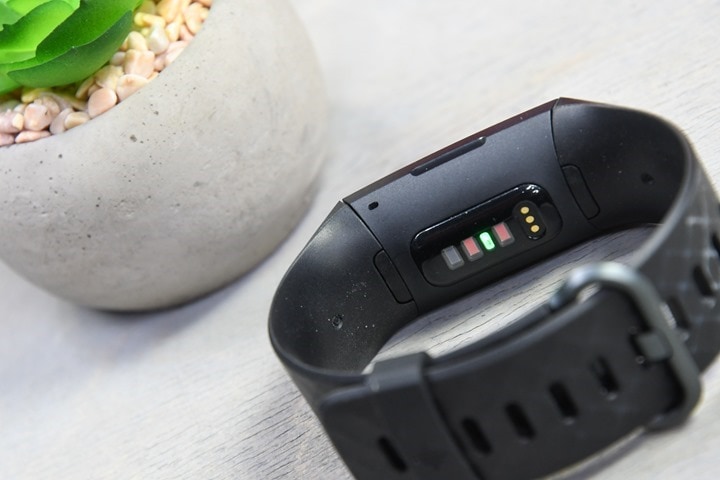
Next up we’ve got heart rate accuracy. This roughly falls into two buckets: 24×7 HR, and workout HR. As is usually the case with most devices these days, I see no tangible issues with 24×7 HR (it’s exceptionally rare that I see issues in this realm, given how easy it is). It works well across both normal daily routines as well as things like sleep. Speaking of which, I talk about RHR values and 24×7 monitoring here and why it’s interesting.
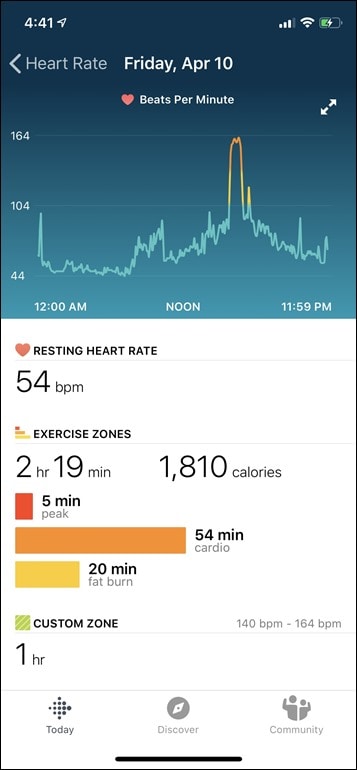
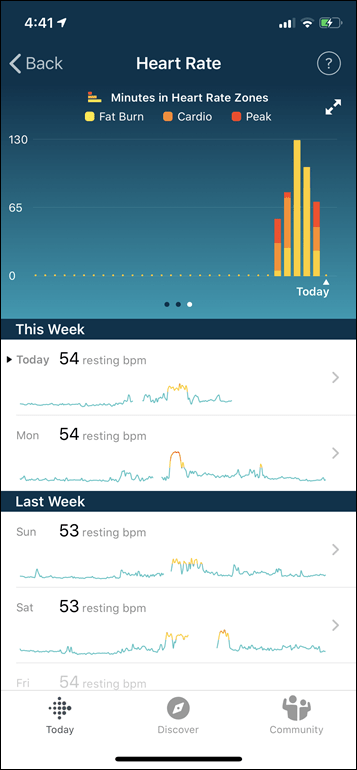
Before we move on to the test results, note that optical HR sensor accuracy is rather varied from individual to individual. Aspects such as skin color, hair density, and position can impact accuracy. Position, and how the band is worn, are *the most important* pieces. A unit with an optical HR sensor should be snug. It doesn’t need to leave marks, but you shouldn’t be able to slide a finger under the band (at least during workouts). You can wear it a tiny bit looser the rest of the day.
Ok, so in my testing, I simply use the watch throughout my normal workouts. Those workouts include a wide variety of intensities and conditions, making them great for accuracy testing. I’ve got steady runs, interval workouts on both bike and running.
For each test, I’m wearing additional devices, usually 3-4 in total, which capture data from other sensors. Typically I’d wear a chest strap (usually the Garmin HRM-DUAL or Polar H10, but also Polar H9) as well as another optical HR sensor watch on the other wrist (lately the Whoop band, Polar OH1 Plus, as well as the new Mio Pod). Note that the numbers you see in the upper right corner are *not* the averages, but rather just the exact point my mouse is sitting over. Note all this data is analyzed using the DCR Analyzer, details here.
Note: Fitbit (still, years later) doesn’t provide any way to export indoor workouts from a HR standpoint (downloadable TCX files like their outdoor workouts, the indoor workouts basically just fire empty blank files). As such, I’ve not done any comparisons there. Typically speaking watches do better indoors than outdoors (lack of bounce when outdoors, colder conditions with outdoors, vibrations outdoors). So, in essence, Fitbit is being judged on their outdoor performance which is probably making them look worse than they are. Perhaps they’ll get around to implementing a way to export indoor workouts, and then perhaps I’ll be able to give them credit for indoor performance. Perhaps.
We’re going to start with something simple here first, a relatively tame 10KM run with no major changes in heart rate. Don’t worry, we’ll get to the intervals in just a second. Here’s the first data set, compared against a Garmin HRM-DUAL chest strap and a Whoop band.

Digging into the first part a bit you can see that both the Fitbit Charge 4 and the Whoop strap are initially inaccurate during the build. They ramp-up too quickly, and are likely picking up cadence there. The slow-roll of the chest strap is more accurate to what I was actually feeling as I began my run down a very slight decline.

Still, by the two-minute marker all three were in agreement. Now don’t let this zoomed in view below confuse you, the changes in HR are mostly minor here, it’s just the scale has changed as well. Most of this is only changes of a couple of BPM. The Whoop strap was consistently underperforming here for some odd reason. But the Fitbit Charge 4 and chest strap were nearly identical. Even in some minor surges I did, the Fitbit Charge 4 stayed the course.

About the only time the Fitbit Charge 4 did anything funky was towards the end with one slightly higher intensity section where it seemed to stumble for about 20 seconds or so, and decreased HR instead of increased it. Though, it did properly recover.

Next, let’s move onto something more challenging – an interval run. This one is with the same other units as before, but also includes the Timex R300’s optical HR sensor as well. Here’s that data set:

Taking a closer look at the first 10 minutes (warm-up), you can see this is an example of a chest strap getting it wrong. It took a bit too long for it to lock-on to my HR, while the optical HR sensors began their inclines at the appropriate effort. The Fitbit Charge 4 was among the faster of the group here, but all of them varied by only a handful of seconds. The Charge 4 was nice and consistent throughout this warm-up.

Next, it’s interval time. This first bump you see is more of a kick up in pace than a true interval. Basically a build. But after that, those are legit intervals at approximately 6:10-6:20/mile (3:45-4:00/km). Nice cruisin’ pace.

The simple version of the above is that the Fitbit Charge 4 is mostly pretty darn good. The Whoop strap in blue did less than awesome (par for the course – I find it very often will snip the tops off of hard efforts – as it did here). The Timex R300 totally lost the boat on the first build interval, but was perfectly fine after that.
About the only complaint I’d have on the Fitbit Charge 4 is on intervals #4 and #6 (last one above), you see the green Fitbit Charge 4 line struggles a bit at the upper end. Not massively so, but not quite super accurate either.
However, where it nailed the longer intervals, it really struggled with these 30-second short sprints. In this case, for the first two of them it totally missed the boat (but hey, Whoop got it right). And on the 3rd, it got the increase part right, but seemed to get distracted after that.

Granted, I don’t know how often most people using this watch would be doing 30-second hard-effort sprints. The earlier 800m long intervals were probably more common.
Finally, let’s take a look at an outdoor ride. Here’s that data. As you’re probably looking at the below, it’s best summarized as: Oh dear god.

Now, this ride was a mess on multiple fronts – and optical HR was only one of them. So, in order to make things kinda easy to understand, I’m going to zoom in on the section from roughly 50 minutes to 90 minutes. This is the ‘cleanest’ section in terms of stability, which makes it easier to see what’s happening. And then I highlighted the parts where it’s inaccurate.

You know what the good news here is? I don’t have to spend any time creating a bunch of screenshots and annotations for this, it’s inaccurate just shy of 100% of the time (I’d go with a generous 98.3%). There’s nothing more to say. Fitbit’s optical sensor has always struggled outdoors riding, and that’s no different here. Same-same.
Ok, so ignoring rides, that leaves us with outdoor runs. And by and large, it’s actually pretty darn good there. The bulk of the main intervals were very close, with it only stumbling on the shorter sprints. As for indoor workouts, again, Fitbit still hasn’t figured out how to create a simple exportable file for those workouts that actually has data in it (they do so for outdoor workouts). As such, I can’t export out the potentially really nice clean indoor workouts I did on a Peloton bike that matched up to other HR devices easily. Maybe one day they’ll complete that homework and I’ll be able to show that. Or not. Their choice.
Wrap-Up:
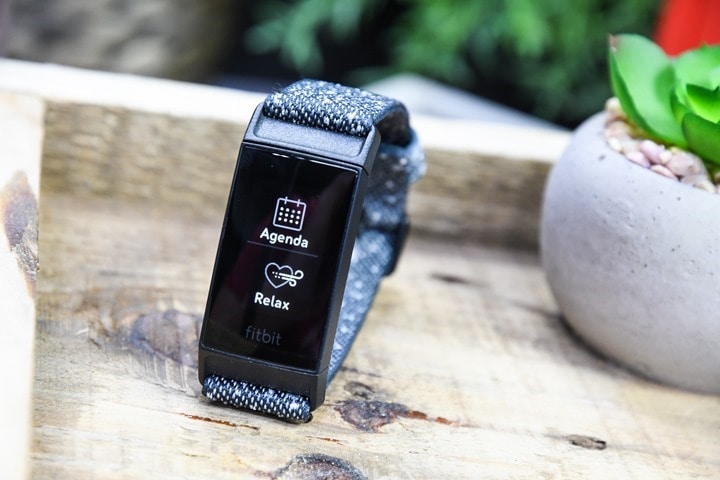
Overall, the Fitbit Charge 4 may actually be the best activity tracker they’ve made in a long while. In recent years it seemed like Fitbit had lost their way a bit. This primarily occurred while they focused on slightly higher-end Versa and Ionic units, which struggled to compete in appeal-factor with the Apple Watch as that price dropped. The other more budget-friendly wearables just didn’t seem to get the focus of years prior.
However, the Charge 4’s addition of GPS and contactless payments not only makes it more appealing, but makes it incredibly competitive price-wise. In fact, I’d argue it makes it probably a bit underpriced. But it’s priced perfectly to sell well. If they had priced it at $ 179, it’d sell OK, but I think at $ 149 a lot of people will rightly say “That’s quite reasonable.”
The Charge 4’s GPS accuracy is more than adequate, and largely speaking doesn’t have any issues keeping up with GPS units that cost 5-7x the price of the Charge 4. And the HR sensor in running seems to be pretty solid too. The new zone features (and colored map) while minor, are nice touches that give the sport and exercise realm of Fitbit a bit more attention. There’s also areas I couldn’t review, such as the female health tracking metrics. Those aren’t new in the Charge 4, but are certainly a notable and oft-discussed component of the larger Fitbit platform.
My only complaints with the Charge 4 would be the GPS-on battery burn rate is a bit high (and only gets 4-5hrs of life there). When not using GPS, the battery is quite nice however and seems to track towards their battery life claims of 7 days. Also, I found the Spotify integration spotty at best.
Still, you’d be hard pressed to find a better all-around activity tracker with GPS at this price point. And that ignores Fitbit’s vast platform which has some of the best social focused features to try and encourage you or your friends to keep active. Even if we’re all stuck inside.
With that – thanks for reading!
Found this review useful? Or just wanna save a bundle?

Hopefully you found this review useful. At the end of the day, I’m an athlete just like you looking for the most detail possible on a new purchase – so my review is written from the standpoint of how I used the device. The reviews generally take a lot of hours to put together, so it’s a fair bit of work (and labor of love). As you probably noticed by looking below, I also take time to answer all the questions posted in the comments – and there’s quite a bit of detail in there as well.
I’ve partnered with Clever Training to offer all DC Rainmaker readers exclusive benefits on all products purchased. By joining the Clever Training VIP Program, you will earn 10% points on this item and 10% off (instantly) on thousands of other fitness products and accessories. Points can be used on your very next purchase at Clever Training for anything site-wide. You can read more about the details here. By joining, you not only support the site (and all the work I do here) – but you also get to enjoy the significant partnership benefits that are just for DC Rainmaker readers. And, since this item is more than $ 99, you get free 3-day (or less) US shipping as well.
Fitbit Charge 4 with GPS
Fitbit Charge 4 Special Edition (basically an extra band) – Select from dropdown
Additionally, you can also use Amazon to purchase the unit (all colors shown after clicking through to the left) or accessories (though, no discount on Amazon). Or, anything else you pick up on Amazon helps support the site as well (socks, laundry detergent, cowbells). If you’re outside the US, I’ve got links to all of the major individual country Amazon stores on the sidebar towards the top. Though, Clever Training also ships there too and you get the 10% discount.
Thanks for reading!

